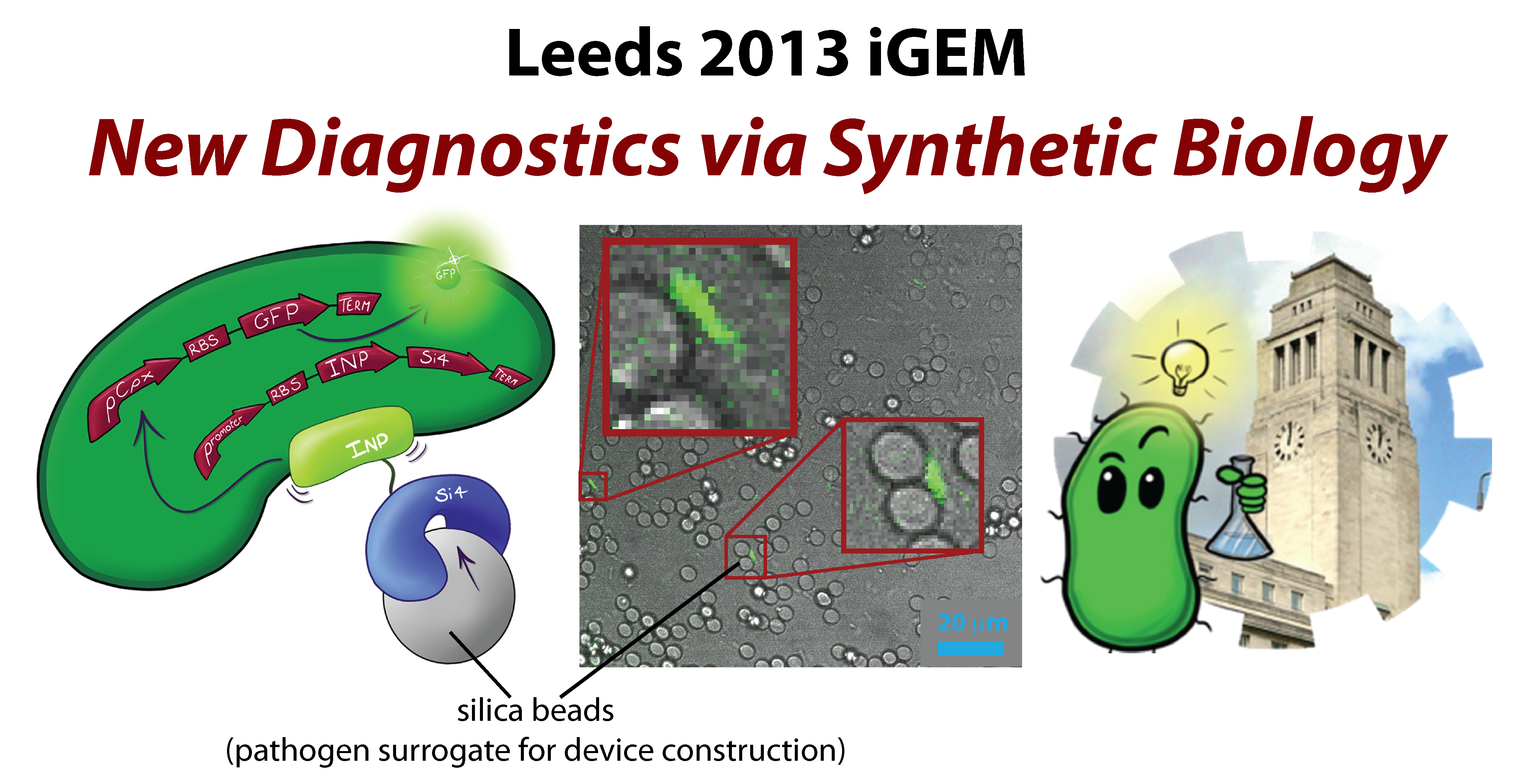Team:Leeds
From 2013.igem.org
| Line 11: | Line 11: | ||
<br> | <br> | ||
==[[Team:Leeds/Project | The Microbeagle]]== | ==[[Team:Leeds/Project | The Microbeagle]]== | ||
| - | Micro-Beagle is a novel reporter system for E-coli that, as an iGEM first, has been designed to dynamically detect arbitrary target solids (including other cells) through a mechanism activated by cell surface binding. Micro-Beagle is a modular system, utilising Ice Nucleation Protein to express and position target-binding peptides on the cell surface. Target binding induces membrane stress that activates the Cpx signalling pathway, and Micro-Beagle thus utilises a promoter from this pathway (pCpxR) to initiate expression of a reporter protein, such as GFP. As a proof of concept, we have used silica beads as a model diagnostic target (a pathogen surrogate) and the silica-binding “Si4” sequence as the target-binding peptide. We foresee Micro-Beagle being adapted for both the detection of waterborne pathogens and a variety of other diagnostic applications, and we envision future multisensor Micro-Beagles in which diverse pathogens can be simultaneously and quantitatively measured from a single water sample | + | <font size="4">A biological system designed to detect the presence of macrostructures in solution </font> |
| + | <br> | ||
| + | |||
| + | Micro-Beagle is a novel reporter system for E-coli that, as an iGEM first, has been designed to dynamically detect arbitrary target solids (including other cells) through a mechanism activated by cell surface binding. | ||
| + | <br> | ||
| + | Micro-Beagle is a modular system, utilising Ice Nucleation Protein to express and position target-binding peptides on the cell surface. Target binding induces membrane stress that activates the Cpx signalling pathway, and Micro-Beagle thus utilises a promoter from this pathway (pCpxR) to initiate expression of a reporter protein, such as GFP. | ||
| + | <br> | ||
| + | As a proof of concept, we have used silica beads as a model diagnostic target (a pathogen surrogate) and the silica-binding “Si4” sequence as the target-binding peptide. | ||
| + | <br> | ||
| + | We foresee Micro-Beagle being adapted for both the detection of waterborne pathogens and a variety of other diagnostic applications, and we envision future multisensor Micro-Beagles in which diverse pathogens can be simultaneously and quantitatively measured from a single water sample | ||
| + | |||
| + | <br> | ||
| + | |||
Like the Beagle hunting dog chasing hares, our Micro-beagle is a biosensor designed to hunt down pathogens. Micro-beagle utilises the Cpx pathway and GFP, which, when it fluoresces can be seen with the naked eye. | Like the Beagle hunting dog chasing hares, our Micro-beagle is a biosensor designed to hunt down pathogens. Micro-beagle utilises the Cpx pathway and GFP, which, when it fluoresces can be seen with the naked eye. | ||
<br> | <br> | ||
Revision as of 14:56, 30 September 2013

The MicrobeagleA biological system designed to detect the presence of macrostructures in solution
Micro-Beagle is a novel reporter system for E-coli that, as an iGEM first, has been designed to dynamically detect arbitrary target solids (including other cells) through a mechanism activated by cell surface binding.
Like the Beagle hunting dog chasing hares, our Micro-beagle is a biosensor designed to hunt down pathogens. Micro-beagle utilises the Cpx pathway and GFP, which, when it fluoresces can be seen with the naked eye.
In order to achieve this we will have designed our biosensor to physically bind to antigens or particles. This binding will induce membrane stress activating the Cpx pathway. By placing the GFP gene downstream of the Cpx promoter, GFP protein will be produced following membrane stress consequently causing the cells tol fluoresce when the pathogen is present in the solution.
As a proof of concept, we will be using silica beads as target analogue for pathogens. In order to bind to the beads will be expressing a silica binding peptide on the surface of the cells using Ice Nucleation Protein (INP). INP allows expression of any gene placed at its C terminus on the cell surface. The theory is that the silica binding peptide sequence can be easily swapped for a sequence of any antigen binding moiety and therefore enable us to detect any pathogen simply, quickly and cheaply.
Upon completion of our project our suggested initial use for the Micro-Beagle will be a low cost easy to use test used to assess the efficacy of water treatment systems. However as stated earlier the detection system can easily be modified to allow any other large particles whose identification could be of value
Who the heck are Leeds?We are the Leeds 2013 iGEM team, We are a group of undergrads from various courses all with a passion for synthetic biology!
Have title: Microbeagle with a one sentence summary of the abstract and then the full abstract below.
| |||||||
 |
| ||||||

| |||||||

| |||||||
 "
"







